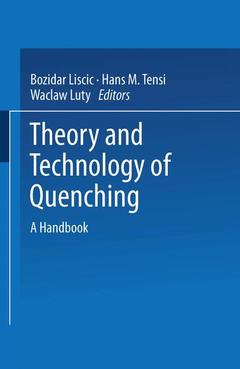Theory and Technology of Quenching, 1992 A Handbook
Langue : Anglais
Coordonnateurs : Liscic Bozidar, Tensi Hans M., Luty Waclaw

Heat treatment of metallic alloys constitutes an important step within the production process. The heat treatment process itself is considered as a cycle of heating the workpieces to a predetermined temperature, keeping them at this temperature for the time period required, and cooling them to room temperature in an appropriate way. The process of heating and keeping workpieces at the required temperature is now adays weil mastered and mostly automatized. The process of cooling or quenching which determines actually the resulting properties, is handicapped with many physical and technical uncertainties. Good results can already be obtained predominantly by using empirically based practice. But increased demands on the properties of the pro ducts as weIl as demands on safety and environment conditions of the quenching media require efforts to investigate the details of the quenching process and to transfer the results of the research to practical application. Advances in the knowledge about quenching processes have been achieved by modem applied thermodynamics especially by the heat and mass transfer researches; further the application of computer technology was helpful to new approaches in quenching pro cesses. Special emphases has been given to: - The theory of heat transfer and heat exchange intensification during quenching - Wetting kinematics - Residual stresses after quenching - Determination of the quenching intensity - Prediction of microstructural transformation and hardness distribution after quenching, the latter with some limitations.
1 Transformation of Steels During Cooling.- 2 Mechanical Properties of Ferrous and Nonferrous Alloys After Quenching.- 3 Thermo- and Fluiddynamic Principles of Heat Transfer During Cooling.- 4 Heat Transfer During Cooling of Heated Metallic Objects with Evaporating Liquids.- 5 Wetting Kinematics.- 6 Residual Stresses After Cooling.- 7 Effect of Workpiece Surface Properties on Cooling Behaviour.- 8 Determination of Quenching Power of Various Fluids.- 9 Types of Cooling Media and Their Properties.- 10 Techniques of Quenching.- 11 Prediction of Hardness Profile in Workpiece, Based on Characteristic Cooling Parameters and Material Behaviour During Cooling.
Date de parution : 04-2014
Ouvrage de 484 p.
15.5x23.5 cm
Disponible chez l'éditeur (délai d'approvisionnement : 15 jours).
Prix indicatif 105,49 €
Ajouter au panierMots-clés :
Abschreckung; Metallbearbeitung; Metallurgy; Quenching; computer; material; metallurgy; metals
© 2024 LAVOISIER S.A.S.



